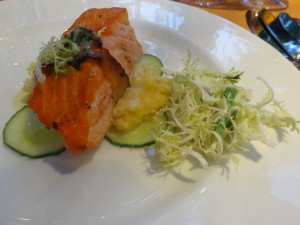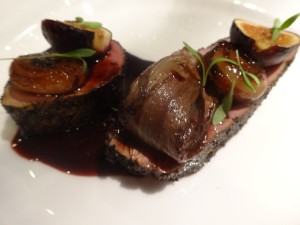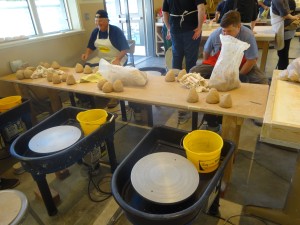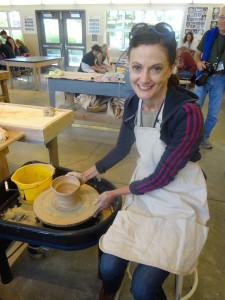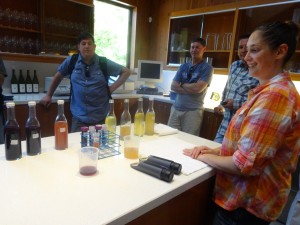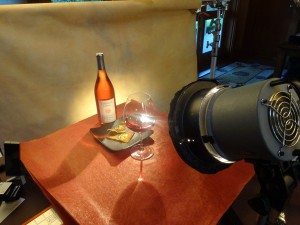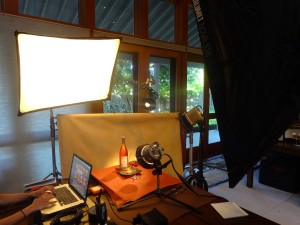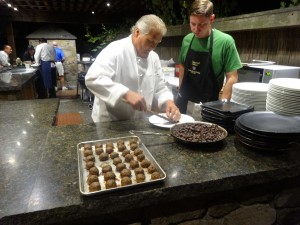Morning Day 3
On our third day of the American Harvest Workshop at Cakebread Cellars we have a super early call time uggh — 6:30 am so we can go pick grapes. Lucky for us they didn’t have us get up for a 2 am night harvest. Breakfast waiting for us in the vineyard again, the sweetest strawberries and pastries from Bouchon Bakery, good fuel for the work ahead. We’re picking in the Foster Road vineyard in Carneros, and these grapes go into the reserve Chardonnay. Quite a big responsibility our crew has, we better not screw it up. The most important thing is that we start and end with 10 fingers. I’ve picked before, but it’s always fun to be in the vineyard, wrangling clusters from the vine, and tasting a few sweet grapes as you pick. In no time at all we’ve filled two bins and send them on their way to the winery.
Meanwhile we head off to Napa Vally College to visit the potters studio. Talk about hands on, we really get our hands dirty here. I’ve never thrown clay on a potter’s wheel, but today is the day to try. What has making ceramics have to do with food and wine? Everything. Consider it part of the culinary arts. It’s all about presentation and the plate plays a major role. Dolores Cakebread developed a relationship with the Napa Valley College Potter’s Guild, inviting them in 1988 to the second American Harvest Workshop, and they have been a regular participant ever since. The chefs use their ceramic platters and plates for the two dinner services. After all, we eat with our eyes and presentation is just as important as what’s on top of the plate. We watch a demo by one of the ceramic artists making what looks like a simple bowl. I am totally intimidated — there is no way I can do that.
We each get a potters wheel and three pieces of clay. A very patient teacher works with us to guide us to getting our shapes right and even. It’s messy work, but boy is it fun. It is amazing how you can shape a block of clay with water on a spinning surface. My first attempt was looking pretty good…until it collapsed. This is so much harder than it looks! I try again and do much better, although the rim is pretty thin and cracking. I also try my hand at another technique, where you take a block of clay, press some wood blocks into it to create any kind of pattern you like, and then you slap it down on the table repeatedly to stretch out the clay into a larger or more oblong shape. Super fun! Mine turned out a little lopsided.
I talk with some of the ceramic artists who tell me what a thrill it is for them to be at the workshop dinners and to see their plates and platters being used to serve the courses, from passed appetizers to plated dishes. One told me it completes the vision she has when she’s creating a piece of pottery.
After we clean up all the clay we got all over ourselves, we head back to the winery, where grapes are coming in from the vineyards, and we get to see crushing and barrel filling. We stop by the all important lab where every day they’re analyzing the grapes for ripeness and quality and testing the wines as they go through fermentation to make sure everything’s on track.
Afternoon day 3
After an alfresco lunch at Cakebread, we sit in on the menu planning session with our chefs who are cooking dinner tonight and tomorrow night. They’re tweaking this evening’s meal. What’s interesting is to hear how the ingredients or sauce or cooking technique that one chef uses impacts the following course. The goal is a harmonious flow from beginning to end, going up that Michael Weiss “tower of power” in flavor and intensity. Each chef makes adjustments to his dish depending on what’s being served in the course that comes before. In addition to the five courses there’s also two passed hors d’oeuvres that have to be prepared. All of us amateur cooks are assigned to work with one of the chefs. I’m working with Jim Severson, chef and owner of Sevy’s Grill in Dallas, TX. He’s been given oysters from Hog Island Oyster Company (on Tomales Bay on the Marin County coast) and Cakebread Sauvignon Blanc to pair.
By midday all five teams are in the Cakebread kitchen, a big kitchen if there’s just a few of you working, but with five teams it’s rocking and there’s not much room to spare. It’s amazing how smoothly things seem to be going, and Cakebread has a team to help us out with finding things in the kitchen and, very importantly, do clean up behind us. There’s several elements to Chef Jim’s dish: a fennel puree, a fennel mignonette, fresh garlic flowers and fennel fronds. The hardest part is shucking the oysters, which after a few attempts I give up on. I am much better with a chef’s knife, so I mince tarragon and fennel. I really enjoy working with Jim; he explains what he’s doing it and why he’s doing it. The little purple garlic flowers have a bite to them when you eat them raw; Jim teaches me by soaking them in ice water that heat calms down and they are more palatable. I taste how he adjusts seasoning as he goes and am quite happy with the mignonette that has fennel, tarragon, lemon juice, rice wine vinegar and the Sauvignon Blanc to act as a bridge between the oysters and the wine.
A little insider’s point of view. All five days we were followed around by photographer Terrence McCarthy, who was constantly snapping action and candid shots. During the two dinner services he took portraits of each dish. I was fascinated by his set up for the plated dishes with a bottle and glass of Cakebread wine. As a TV producer I know wine bottles are notoriously hard to shoot, thanks to the reflection and glare of the glass. Terry uses at least four lights, from different directions, to deal with that issue. Fun to see what goes on behind the scenes.
It’s go time when it comes our moment to plate and serve. There are 65 servings, each with three oysters on the plate with a bed of rock salt. It takes about 6 of us to get all the dishes done, and chef Tom from Cakebread is on us to pick up the pace and get it done faster. We have to squeeze the fennel puree under the oyster, top it with the mignonette, garlic flower and fennel frond. The plates look beautiful going out, and all the guests at Cakebread happily slurp them down. It was fun to eat something I had a part in making, and I can’t wait for tomorrow night’s dinner prep, where we’ve got the lamb course and we’ll be making albondigas (Mexican meatballs). Jim assures me it will be a more intense prep and cook.
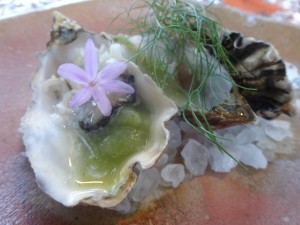
Throughout the dinner, even though the chefs had been assigned their proteins and wine, their personality came out through their food.
